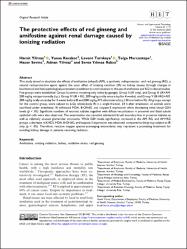| dc.contributor.author | Yılmaz, Hamit | |
| dc.contributor.author | Karakoç, Yunus | |
| dc.contributor.author | Tümkaya, Levent | |
| dc.contributor.author | Mercantepe, Tolga | |
| dc.contributor.author | Sevinç, Hacer | |
| dc.contributor.author | Yılmaz, Adnan | |
| dc.contributor.author | Rakıcı, Sema Yılmaz | |
| dc.date.accessioned | 2023-03-21T06:03:09Z | |
| dc.date.available | 2023-03-21T06:03:09Z | |
| dc.date.issued | 2022 | en_US |
| dc.identifier.citation | Yilmaz, H., Karakoc, Y., Tumkaya, L., Mercantepe, T., Sevinc, H., Yilmaz, A., & Yılmaz Rakıcı, S. (2022). The protective effects of red ginseng and amifostine against renal damage caused by ionizing radiation. Human & experimental toxicology, 41, 9603271221143029. https://doi.org/10.1177/09603271221143029 | en_US |
| dc.identifier.issn | 0960-3271 | |
| dc.identifier.issn | 1477-0903 | |
| dc.identifier.issn | 0960-3271 | |
| dc.identifier.uri | https://doi.org/10.1177/09603271221143029 | |
| dc.identifier.uri | https://hdl.handle.net/11436/7937 | |
| dc.description.abstract | This study aimed to elucidate the effects of amifostine (ethyol) (AM), a synthetic radioprotector, and red ginseng (RG), a natural radioprotective agent, against the toxic effect of ionizing radiation (IR) on kidney tissues through changes in biochemical and histopathological parameters in addition to contributions to the use of amifostine and RG in clinical studies. Five groups were established: Group I (control, receiving only saline by gavage), Group II (IR only), and Group III (IR+AM, 200 mg/kg intraperitoneally (i.p.). Group IV (IR + RG, 200 mg/kg orally once a day for 4 weeks), and Group V (IR+RG+AM, 200 mg/kg orally once/day for 4 weeks before IR and 200 mg/kg AM administered (i.p.) 30 min before IR). All groups, except for the control group, were subject to 6-Gy whole-body IR in a single fraction. 24 h after irradiation, all animals were sacrificed under anesthesia. IR enhanced MDA, 8-OHdG, and caspase-3 expression while decreasing renal tissue GSH levels (p < .05). Significant numbers of necrotic tubules together with diffuse vacuolization in proximal and distal tubule epithelial cells were also observed. The examination also revealed substantial brush boundary loss in proximal tubules as well as relatively unusual glomerular structures. While GSH levels significantly increased in the AM, RG, and AM+RG groups, a decrease in KHDS, MDA, 8-OHdG, and caspase-3 expression was observed, compared to the group subject to IR only (p < .05). Therefore, reactive oxygen species-scavenging antioxidants may represent a promising treatment for avoiding kidney damage in patients receiving radiation. | en_US |
| dc.language.iso | eng | en_US |
| dc.rights | info:eu-repo/semantics/openAccess | en_US |
| dc.subject | Amifostine | en_US |
| dc.subject | Ionizing radiation | en_US |
| dc.subject | Kidney | en_US |
| dc.subject | Oxidative stress | en_US |
| dc.subject | Red ginseng | en_US |
| dc.title | The protective effects of red ginseng and amifostine against renal damage caused by ionizing radiation | en_US |
| dc.type | article | en_US |
| dc.contributor.department | RTEÜ, Tıp Fakültesi, Temel Tıp Bilimleri Bölümü | en_US |
| dc.contributor.institutionauthor | Tümkaya, Levent | |
| dc.contributor.institutionauthor | Mercantepe, Tolga | |
| dc.contributor.institutionauthor | Sevinç, Hacer | |
| dc.contributor.institutionauthor | Yılmaz, Adnan | |
| dc.contributor.institutionauthor | Rakıcı, Sema Yılmaz | |
| dc.identifier.doi | 10.1177/09603271221143029 | en_US |
| dc.identifier.volume | 41 | en_US |
| dc.relation.journal | Human & experimental toxicology | en_US |
| dc.relation.publicationcategory | Makale - Uluslararası Hakemli Dergi - Kurum Öğretim Elemanı | en_US |


















